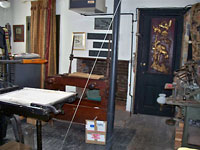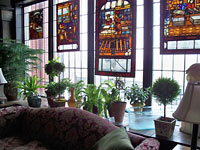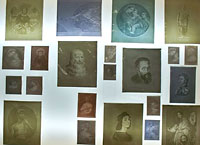A Passion for Paper
But it’s the room on the left at the end of the hall that holds the greatest interest for bibliophiles. This is what remains of Mountain House Press. Hunter’s iron hand press is still there, although it sits idle these days, except for occasional classroom demonstrations. Hunter’s books and archival material are everywhere.
“When his father died, Dard (III) discovered papers that no one knew were in the house. There were piles of them in brown paper bags,” said Baker. Baker came to Mountain House at Hunter’s invitation to help organize the cache, then stayed on to finish Hunter’s biography. “It had been started by Patricia Scott, but she died before she had gone very far with it,” said Baker—and before all the archival material had surfaced. Baker basically started the biography from scratch.
Today, Mountain House is owned by Hunter’s grandson. He lives there and carries on his handicraft heritage at a workshop in town, printing stationery and cards. He also frames prints, including reproductions of his grandfather’s Roycroft work. Other prints, tiles, and art objects by modern artists working in the Roycroft style are also available.
As the current owner and resident of Mountain House, Hunter III is comfortable with his legacy, and is determined to carry the family business forward, at the Dard Hunter Studios, through an annual conference, and in traveling exhibits that feature the work of his grandfather.
“That’s my business—to carry on the work started by my grandfather,” said Hunter III.
He’s not the only one to preserve Hunter’s legacy of craftsmanship. Amy Jackson, an undergraduate student in printing and the book arts at Virginia’s Longwood University is just as eager to continue Hunter’s work. “I’ve always been an advocate for the hand arts,” she said. “And Hunter was the man who brought hand papermaking to America.”
Jackson said she hopes to follow in Hunter’s footsteps, and is already considering a way to use the Russian Olive, an invasive plant species in Virginia, to make paper. “Hunter used natural elements to make his paper, but he was still conscious of the environment,” she said. That’s why the ubiquitous Russian Olive seems ideal. “I’d love to cook down its fiber to make paper, and use its leaves to make an interesting ink,” she added.
Hunting for Hunter
A collection of Dard Hunter’s books can be found at the Robert E. and Jean R. Mahn Center for Archives and Special Collections at the Ohio University Library, Park Place, Athens, OH. An online exhibit is also available.
The Robert C. Williams Paper Museum’s Dard Hunter Collection contains artifacts and books on paper and papermaking. The Museum’s current exhibit, “Hidden Treasures: Watermarks from the Permanent Collection,” runs from March 11, 2010 through June 4, 2010. Address: Institute of Paper Science and Technology, Georgia Tech, 500 10th Street NW, Atlanta, GA.
The Friends of Dard Hunter is a membership organization that promotes and encourages the continued and creative practice of hand papermaking, allied paper arts, the book arts, and other arts practiced by Dard Hunter. The group also maintains a blog.
Like Jackson, many book artists still look to Hunter for inspiration. Some make the pilgrimage to Mountain House. Those who do are not disappointed.
Standing in the front room of the home and looking through the picture windows, it’s easy for visitors to understand Hunter’s perspective on his art and his life. Distanced, as they are, from the small details, they’re forced to focus on the panorama spread before them.
Hunter’s focus was not just on papermaking, said Baker, or on printing or type design or bookbinding. She continued, “he was fascinated by all aspects of the book arts. He never looked at one thing in isolation. He looked at the whole picture.”
Those who appreciate the book arts value that vision. After all, it’s not just the single page that counts. It’s the book itself in its beautiful entirety.












